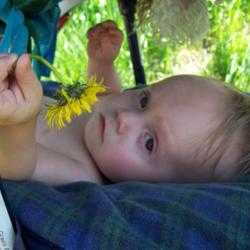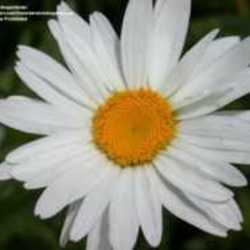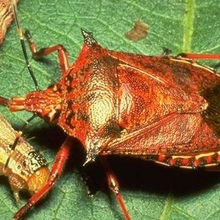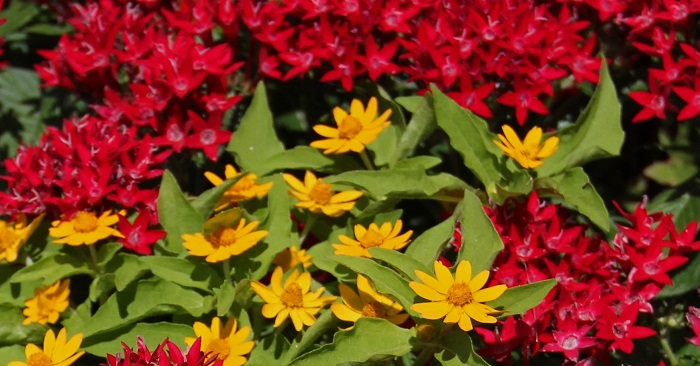
Butter Daisy, a Low Maintenance Annual
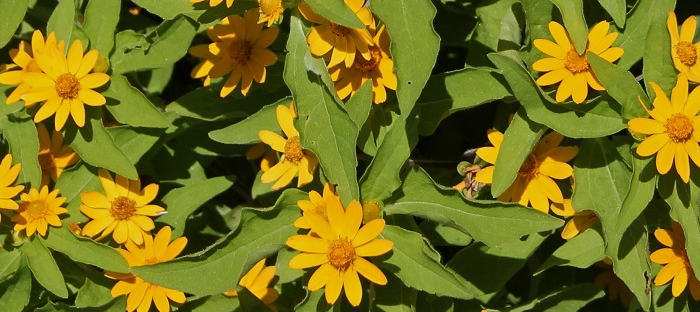
Thinking back on which annuals have been the highest performers, I immediately think of butter daisy.
Year after year it reseeds in the flowerbed out by the street where it is subjected to the hot, afternoon sun and the reflected light from the surrounding pavement. It begins blooming almost as soon as it emerges from the ground, and it stays in bloom until frost kills it.
Butter daisy (Melampodium divaricatum) proved to be just the right choice one year when my class of sixth graders decided to do something about an empty planter outside the classroom door. For several years it had been the perfect place to discard chewing gum wrappers or bits and pieces of candy and other items that were not allowed in the classroom. We discussed the matter one spring day and decided that this ugly sight could be improved. Some colorful flowers would make the area much more pleasant. We knew we needed something tough because the brick planter was in full sun most of the day, and it was surrounded by brick and concrete.
In a search for possibilities, I visited a nearby nursery. No sooner than I entered the gate, I was smitten with the bright yellow daisy-like, nickel size flowers of the butter daisies. “Those,” I thought to myself, “would delight the students and look great in the red brick planter.” I bought the tray of plants, took them to school the next day, and the students and I planted them.
Planting Techniques and Aftercare
First we cleaned out the planter, added some soil amendments, and sprinkled the soil with a balanced, slow release fertilizer. Then the students planted the butter daisies and watered them in well. After snuggling some pine needle mulch around the tiny plants, we resumed the laborious task of learning about prepositional phrases.
As we continued our studies, the little plants grew and filled in the planter. A solid mass of bright yellow blossoms brightened the red brick planter and wall behind it. Students who finished their work early were allowed to weed and water the plants. Competition was keen for this pleasant task.
Finally summer vacation arrived and the flowers were left to fend for themselves. Even though these students progressed to the seventh grade, I found a few of them sneaking back into the sixth grade area to check on their flowers. Smiles lit their faces when they realized the flowers were still there – still growing strong, and still beautiful.
Winter came, and with it the death of the melampodiums. The dead plants were pulled from the planter and nothing was left except the pine needle mulch. The following spring, the sixth graders noticed tiny seedlings springing up in the planter. They were much too thick, so the plants were thinned and the children took some of the seedlings home to plant in their gardens.
These tough little plants are very easy to grow, so they were perfect for a child’s first gardening experience. Butter daisies are practically disease and insect free. No pinching is needed, since they are self branching. Furthermore, their self cleaning characteristic means that no deadheading is needed. Florida’s heat and humidity bothered them not in the least. They are truly low-maintenance, high performing plants.

Confusing Nomenclature
Research done since that time reveals that the nomenclature for Melampodium is very confusing. Some references list it as Melampodium divaricatum; others as Melampodium paludosum. I believe, but am not quite certain, that the correct name is M. divaricatum, and that M. paludosum is a synonym. Another synonym is Dysodium divaricatum. In all, there are several species of Melampodium. Wikipedia says there are 39 species; GRIN (Germplasm Resources Information Network) lists three species, and these are the ones about which I found information.
Other Species
Other than Melampodium divaricatum, the blackfoot daisy or plains blackfoot (M. leucanthum), found in Arizona, Colorado, Kansas, New Mexico, Texas, is a perennial bearing many yellow-centered white flowers. Gardeners in the arid southwest appreciate this plant because it is extremely drought tolerant and is attractive to bees, butterflies, and birds. Dave’s Garden has many positive comments about this plant from Texas gardeners.
Melampodium perfoliatum (perfoliate blackfoot) is another species characterized by its perfoliate leaves which completely enclose the stem so that the stem appears to pass through it. This annual is native to Central and South America, and can be found in California, though it is not native there. In nature, stands can be found on hillsides and forest clearings, and it is a common weed in certain crops, including corn, avocado, coffee, sugar cane, and other crops. It seems that this plant most likely not the friendly plant we’ve grown to love as we have the butter daisy.
Family and Name Information
All melampodiums are members of the Asteraceae family. Their inflorescence (flower cluster) is a capitulum, containing both disk and ray flowers. The seeds are achenes, or a simple dry fruit produced by many plants, such as sunflower and most members of the Asteraceae family, as well as many other plants. Melampodium is derived from the Greek words melas, meaning black, and podion, meaning foot. This aptly describes the color of the stem base and the roots, explaining why members of the genus are sometimes referred to as the blackfoots.
Cultivars
The butter daisy is known by such common names as butter daisy, star daisy, gold medallion flower, and I’m sure there are others. Several cultivars have been introduced, mostly in smaller sizes than the species. Some of the most compact cultivars are ‘Million Gold’, ‘Lemon Delight’, ‘Melanie’, and ‘Derby’ which grow about 10 inches tall and are great for front of the border or for a bright groundcover. Growing a bit taller is ‘Showstar’, reaching 14 to 24 inches tall. The tallest is ‘Medallion’, reaching 24 to 36 inches tall.
Plant butter daisy en masse in flower beds and borders, or group them with other colorful annuals and perennials. The smaller cultivars are great in containers and will brighten any spot. You can hardly go wrong, especially if what you want is a bed of bright yellow, non-stop flowers throughout the long, hot summer.
Images courtesy of Melody Rose
Popular Gardening Topics


